stop start CHEVROLET KODIAK 2004 Owners Manual
[x] Cancel search | Manufacturer: CHEVROLET, Model Year: 2004, Model line: KODIAK, Model: CHEVROLET KODIAK 2004Pages: 366, PDF Size: 6.87 MB
Page 79 of 366
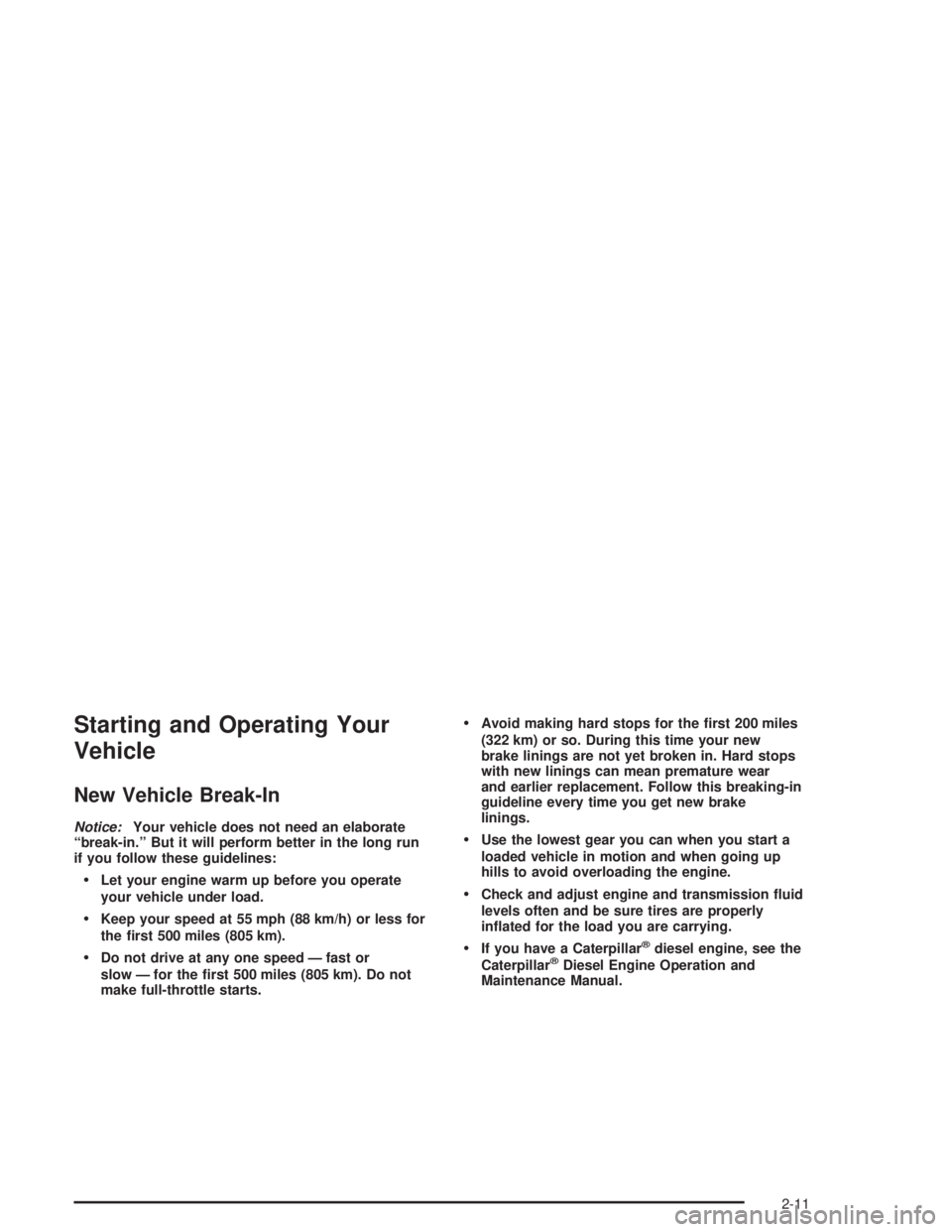
Starting and Operating Your
Vehicle
New Vehicle Break-In
Notice:Your vehicle does not need an elaborate
“break-in.” But it will perform better in the long run
if you follow these guidelines:
Let your engine warm up before you operate
your vehicle under load.
Keep your speed at 55 mph (88 km/h) or less for
the �rst 500 miles (805 km).
Do not drive at any one speed — fast or
slow — for the �rst 500 miles (805 km). Do not
make full-throttle starts.
Avoid making hard stops for the �rst 200 miles
(322 km) or so. During this time your new
brake linings are not yet broken in. Hard stops
with new linings can mean premature wear
and earlier replacement. Follow this breaking-in
guideline every time you get new brake
linings.
Use the lowest gear you can when you start a
loaded vehicle in motion and when going up
hills to avoid overloading the engine.
Check and adjust engine and transmission �uid
levels often and be sure tires are properly
in�ated for the load you are carrying.
If you have a Caterpillar®diesel engine, see the
Caterpillar®Diesel Engine Operation and
Maintenance Manual.
2-11
Page 81 of 366
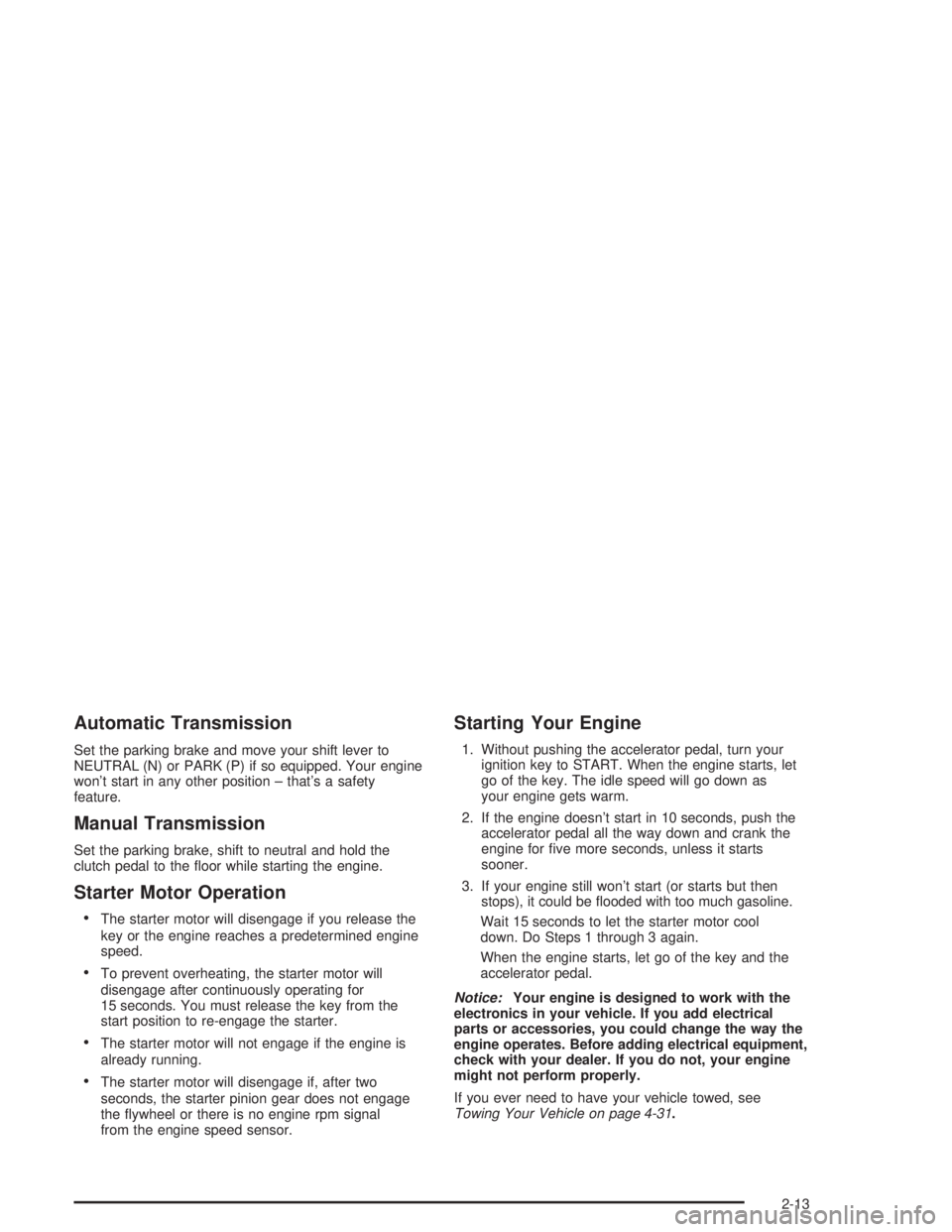
Automatic Transmission
Set the parking brake and move your shift lever to
NEUTRAL (N) or PARK (P) if so equipped. Your engine
won’t start in any other position – that’s a safety
feature.
Manual Transmission
Set the parking brake, shift to neutral and hold the
clutch pedal to the floor while starting the engine.
Starter Motor Operation
•The starter motor will disengage if you release the
key or the engine reaches a predetermined engine
speed.
•To prevent overheating, the starter motor will
disengage after continuously operating for
15 seconds. You must release the key from the
start position to re-engage the starter.
•The starter motor will not engage if the engine is
already running.
•The starter motor will disengage if, after two
seconds, the starter pinion gear does not engage
the flywheel or there is no engine rpm signal
from the engine speed sensor.
Starting Your Engine
1. Without pushing the accelerator pedal, turn your
ignition key to START. When the engine starts, let
go of the key. The idle speed will go down as
your engine gets warm.
2. If the engine doesn’t start in 10 seconds, push the
accelerator pedal all the way down and crank the
engine for five more seconds, unless it starts
sooner.
3. If your engine still won’t start (or starts but then
stops), it could be flooded with too much gasoline.
Wait 15 seconds to let the starter motor cool
down. Do Steps 1 through 3 again.
When the engine starts, let go of the key and the
accelerator pedal.
Notice:Your engine is designed to work with the
electronics in your vehicle. If you add electrical
parts or accessories, you could change the way the
engine operates. Before adding electrical equipment,
check with your dealer. If you do not, your engine
might not perform properly.
If you ever need to have your vehicle towed, see
Towing Your Vehicle on page 4-31.
2-13
Page 82 of 366

Gasoline Engine Warm-Up
When you’ve started your engine, let it run for
20 or 30 seconds to warm up before you put a load on
the engine.
Drive at moderate speeds for the first few miles,
especially in cold weather. Running a cold engine at
high speed can damage it. SeeHigh Idle Systemunder
Starting Your Diesel Engine on page 2-14
Restarting the Gasoline Engine While
Moving (Automatic Transmission)
If you have to restart the engine while the vehicle is
moving, you’ll first have to shift the automatic
transmission to NEUTRAL (N). This safety feature
prevents starting the engine when the transmission is in
a drive gear.
Stopping the Gasoline Engine
Let your engine idle for a few seconds before turning it
off after you have finished driving your vehicle.
If you shift to NEUTRAL (N) or PARK (P), set the
parking brake.
If your vehicle has a two-speed axle, put the range
selector in LOW. To be sure the axle has shifted into
LOW, engage the clutch and transmission; the vehicle
may move slightly when you do this.While your engine is idling before you turn it off, you
can make a list of any operational or handling concerns
to give to responsible maintenance personnel so
they can handle them right away.
Moisture will condense in a fuel tank that is almost
empty if the engine has not run for a while, even just
overnight under some conditions. So, it’s always best to
refuel your vehicle at the end of each run.
Starting Your Diesel Engine
If you have a Caterpillar®diesel engine, also refer to
your Caterpillar®Diesel Engine Operation &
Maintenance Manual for starting procedure.
For vehicles with the DURAMAX™ diesel engine, also
seeStarting Your DURAMAX™ Diesel Engine on
page 2-19.
To make starting easier in cold weather (below 32°F or
0°C), the proper viscosity engine oil should be used.
SeeEngine Oil (Caterpillar
®Diesel Engine) on
page 5-20orEngine Oil (Gasoline Engine) on page 5-20
orEngine Oil (DURAMAX™ Diesel) on page 5-25. It’s
also best to heat the engine oil first. You can do this by
using an engine coolant heater.
If you ever need to have your vehicle towed, see
Towing Your Vehicle on page 4-31.
2-14
Page 83 of 366
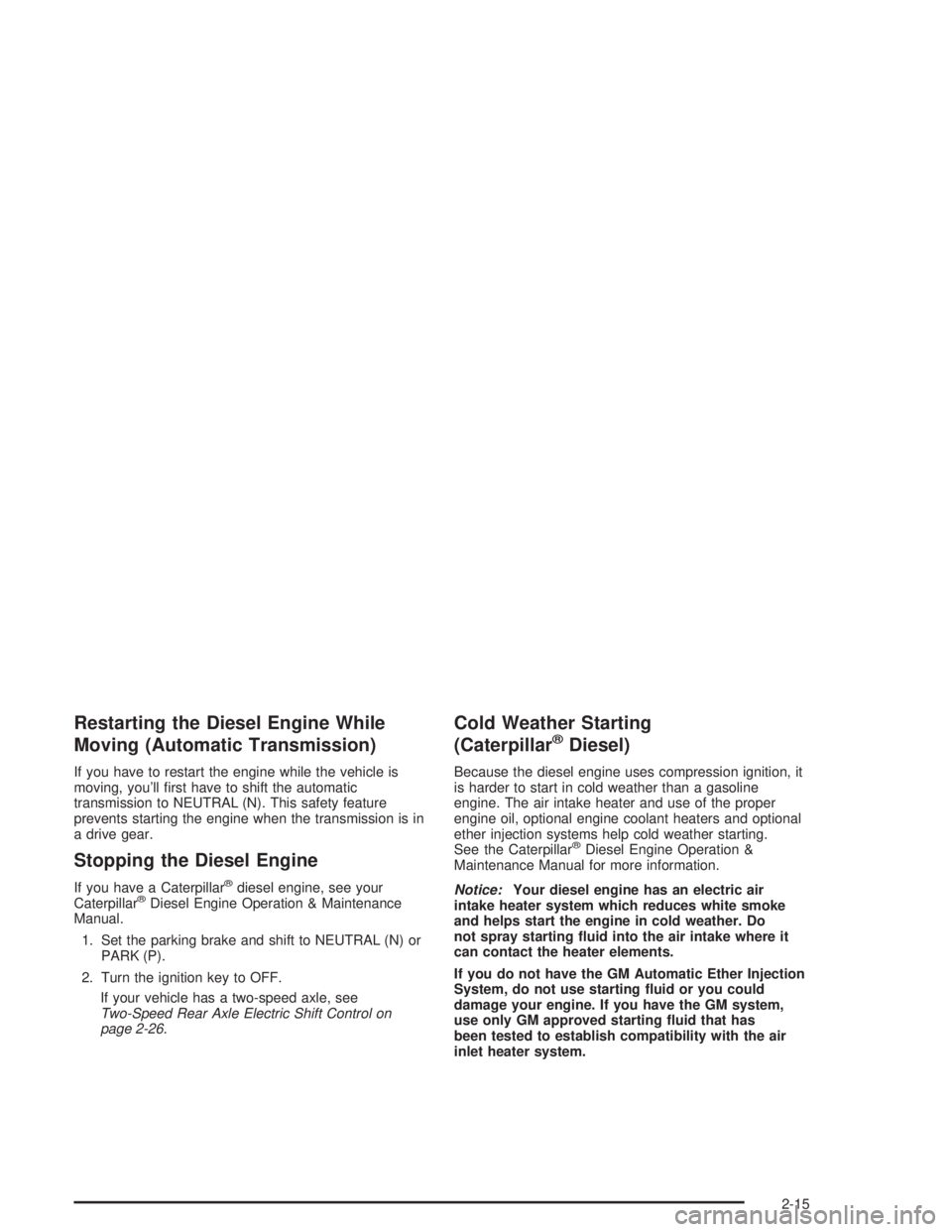
Restarting the Diesel Engine While
Moving (Automatic Transmission)
If you have to restart the engine while the vehicle is
moving, you’ll first have to shift the automatic
transmission to NEUTRAL (N). This safety feature
prevents starting the engine when the transmission is in
a drive gear.
Stopping the Diesel Engine
If you have a Caterpillar®diesel engine, see your
Caterpillar®Diesel Engine Operation & Maintenance
Manual.
1. Set the parking brake and shift to NEUTRAL (N) or
PARK (P).
2. Turn the ignition key to OFF.
If your vehicle has a two-speed axle, see
Two-Speed Rear Axle Electric Shift Control on
page 2-26.
Cold Weather Starting
(Caterpillar®Diesel)
Because the diesel engine uses compression ignition, it
is harder to start in cold weather than a gasoline
engine. The air intake heater and use of the proper
engine oil, optional engine coolant heaters and optional
ether injection systems help cold weather starting.
See the Caterpillar
®Diesel Engine Operation &
Maintenance Manual for more information.
Notice:Your diesel engine has an electric air
intake heater system which reduces white smoke
and helps start the engine in cold weather. Do
not spray starting �uid into the air intake where it
can contact the heater elements.
If you do not have the GM Automatic Ether Injection
System, do not use starting �uid or you could
damage your engine. If you have the GM system,
use only GM approved starting �uid that has
been tested to establish compatibility with the air
inlet heater system.
2-15
Page 87 of 366
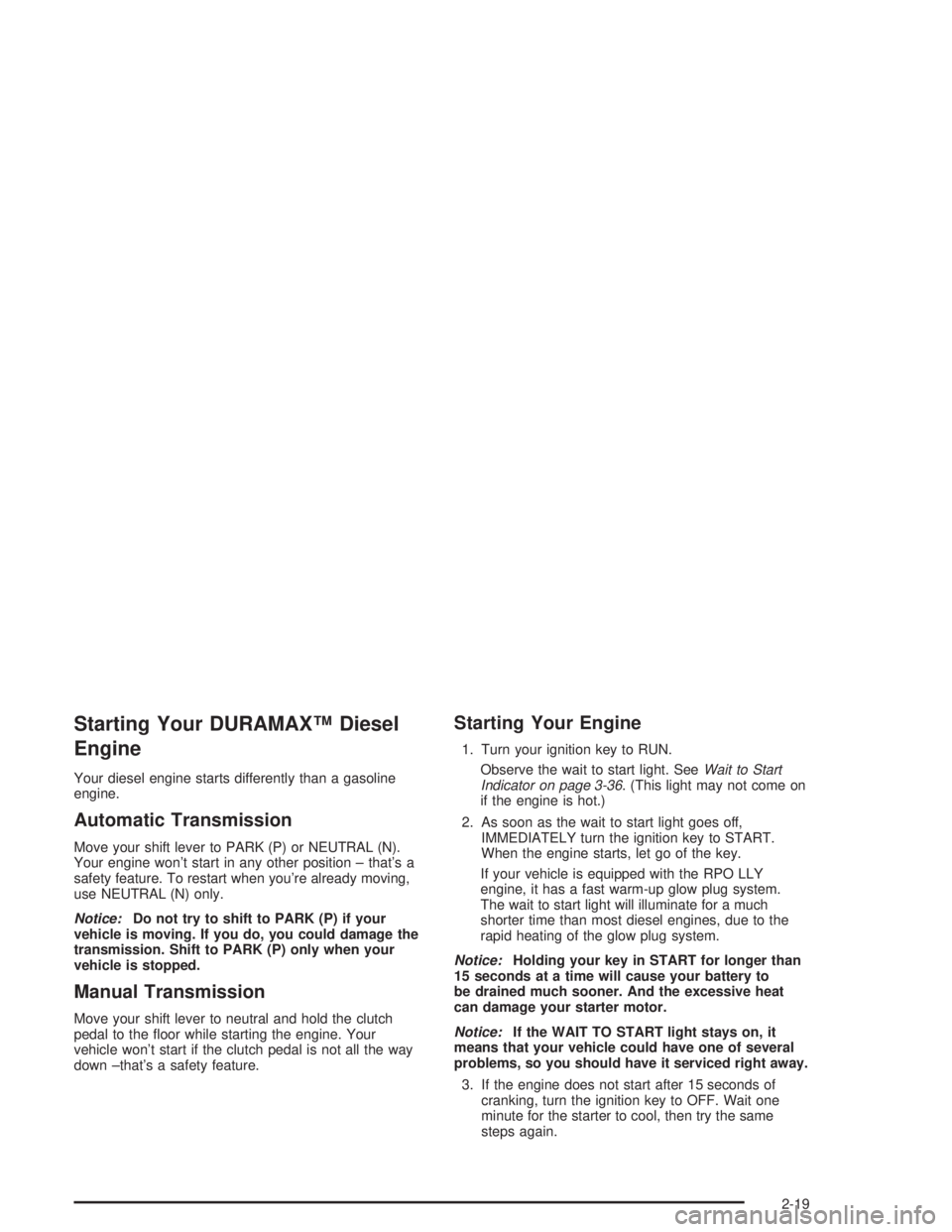
Starting Your DURAMAX™ Diesel
Engine
Your diesel engine starts differently than a gasoline
engine.
Automatic Transmission
Move your shift lever to PARK (P) or NEUTRAL (N).
Your engine won’t start in any other position – that’s a
safety feature. To restart when you’re already moving,
use NEUTRAL (N) only.
Notice:Do not try to shift to PARK (P) if your
vehicle is moving. If you do, you could damage the
transmission. Shift to PARK (P) only when your
vehicle is stopped.
Manual Transmission
Move your shift lever to neutral and hold the clutch
pedal to the floor while starting the engine. Your
vehicle won’t start if the clutch pedal is not all the way
down –that’s a safety feature.
Starting Your Engine
1. Turn your ignition key to RUN.
Observe the wait to start light. SeeWait to Start
Indicator on page 3-36. (This light may not come on
if the engine is hot.)
2. As soon as the wait to start light goes off,
IMMEDIATELY turn the ignition key to START.
When the engine starts, let go of the key.
If your vehicle is equipped with the RPO LLY
engine, it has a fast warm-up glow plug system.
The wait to start light will illuminate for a much
shorter time than most diesel engines, due to the
rapid heating of the glow plug system.
Notice:Holding your key in START for longer than
15 seconds at a time will cause your battery to
be drained much sooner. And the excessive heat
can damage your starter motor.
Notice:If the WAIT TO START light stays on, it
means that your vehicle could have one of several
problems, so you should have it serviced right away.
3. If the engine does not start after 15 seconds of
cranking, turn the ignition key to OFF. Wait one
minute for the starter to cool, then try the same
steps again.
2-19
Page 89 of 366

If your batteries don’t have enough charge to start your
engine, seeBattery on page 5-55.
Be sure you have the right oil for your engine, and that
you’ve changed the oil at the proper times. If you
use the wrong oil, your engine may be harder to start.
Be sure you are using the proper fuel for existing
weather conditions. SeeWhat Fuel to Use on page 5-8.
If the engine starts, runs a short time, then stops,
your vehicle needs service.
{CAUTION:
Do not use gasoline or starting “aids” such as
ether, in the air intake. They could damage
your engine. There could also be a �re, which
could cause serious personal injury.
Elevated Idle/Exhaust Restrictor
If your vehicle is equipped with the RPO LLY engine, it
has a cold temperature high idle and exhaust restrictor
feature which elevates the engines idle speed from
680 to 1200 rpms, and restricts the exhaust gas flow,
when outside temperatures are below 41°F (5°C),
and the engine coolant temperature is below
150°F (65°C.)
This feature enhances heater performance by raising
the engine coolant temperature faster. When the vehicle
is started in outside temperatures below 41°F (5°C),
and the engine coolant temperature is below 150°F
(65°C), the engine will idle at 1200 rpms and the
variable nozzle turbocharger will restrict the
exhaust flow.
To turn on this feature:
1. Turn the ignition to the run position, with the
vehicle off.
2. Press the accelerator pedal to the floor and hold
while quickly pressing the brake pedal three times
in less than eight seconds.
3. Release the accelerator pedal and start the engine.
2-21
Page 90 of 366

When the engine is started, it will slowly ramp up to the
high idle speed after a delay of a few seconds up to
about two minutes. For this method to work properly
there must be no throttle or brake pedal faults, and the
throttle pedal must not fall below 75 percent of wide
open throttle while pressing the brake pedal.
The engine idle speed will return to normal once the
following conditions are met:
•Once engine coolant temperature reaches
150°F (65°C).
•Air intake temperature reaches 41°F (5°C).
The high idle speed will be temporarily interrupted and
the engine speed will return to normal if any of the
following conditions occur:
•The brake pedal is applied.
•The accelerator pedal is pressed.
•The automatic transmission is shifted out of
PARK (P) or NEUTRAL (N).
•The clutch pedal on the manual transmission is
pressed.
•Vehicle speed is detected.
Once these inputs are removed, the engine idle speed
will slowly ramp back up to high idle after the normal
delay, if the conditions for engine coolant temperature
and air intake temperature are still met.
Engine Checks Before Operating
When you’ve started your engine, let it run for
20 to 30 seconds before you put a load on the engine.
Butdon’tleave the vehicle while the engine is running.
Avoid unnecessary idling of diesel engine equipped
vehicles.
If the engine idles too long, the temperature of the
engine coolant will fall below the normal operating
range. Low engine operating temperature causes
several conditions which affect engine operation and
reduce engine life.
The engine should be permitted to go through a
warm-up period. Operate the vehicle at a minimum of
600 rpm during the warm-up period. During this
period and during operation, the following observations
should be made.
During this warm-up period, check your warning lights
and gages:
•If oil pressure doesn’t begin to rise within
15 seconds of starting, stop the engine and find the
cause.
•If the engine coolant temperature gage needle goes
into the hot area on the gage, stop the engine and
find the cause of the overheating.
2-22
Page 91 of 366
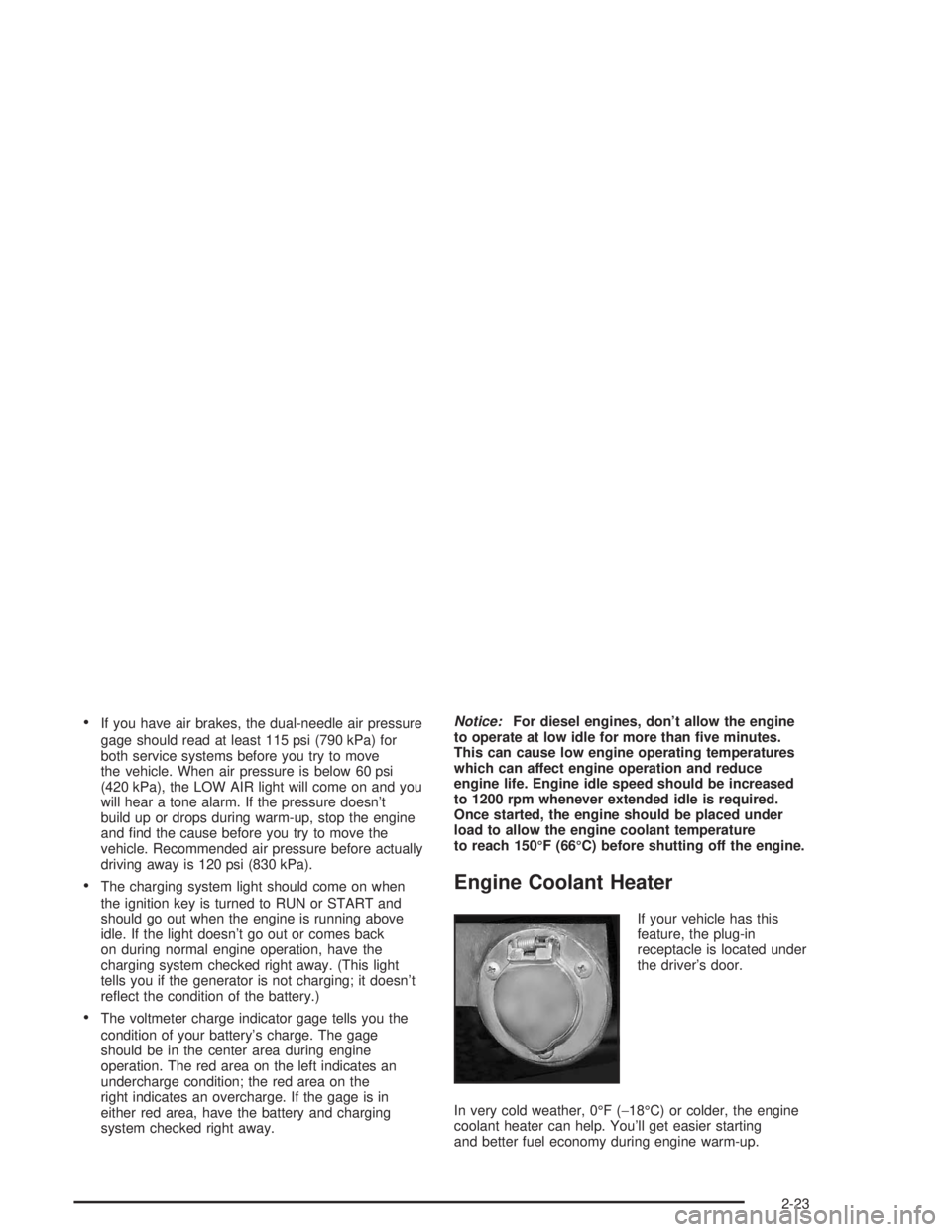
•If you have air brakes, the dual-needle air pressure
gage should read at least 115 psi (790 kPa) for
both service systems before you try to move
the vehicle. When air pressure is below 60 psi
(420 kPa), the LOW AIR light will come on and you
will hear a tone alarm. If the pressure doesn’t
build up or drops during warm-up, stop the engine
and find the cause before you try to move the
vehicle. Recommended air pressure before actually
driving away is 120 psi (830 kPa).
•The charging system light should come on when
the ignition key is turned to RUN or START and
should go out when the engine is running above
idle. If the light doesn’t go out or comes back
on during normal engine operation, have the
charging system checked right away. (This light
tells you if the generator is not charging; it doesn’t
reflect the condition of the battery.)
•The voltmeter charge indicator gage tells you the
condition of your battery’s charge. The gage
should be in the center area during engine
operation. The red area on the left indicates an
undercharge condition; the red area on the
right indicates an overcharge. If the gage is in
either red area, have the battery and charging
system checked right away.Notice:For diesel engines, don’t allow the engine
to operate at low idle for more than �ve minutes.
This can cause low engine operating temperatures
which can affect engine operation and reduce
engine life. Engine idle speed should be increased
to 1200 rpm whenever extended idle is required.
Once started, the engine should be placed under
load to allow the engine coolant temperature
to reach 150°F (66°C) before shutting off the engine.
Engine Coolant Heater
If your vehicle has this
feature, the plug-in
receptacle is located under
the driver’s door.
In very cold weather, 0°F (−18°C) or colder, the engine
coolant heater can help. You’ll get easier starting
and better fuel economy during engine warm-up.
2-23
Page 99 of 366
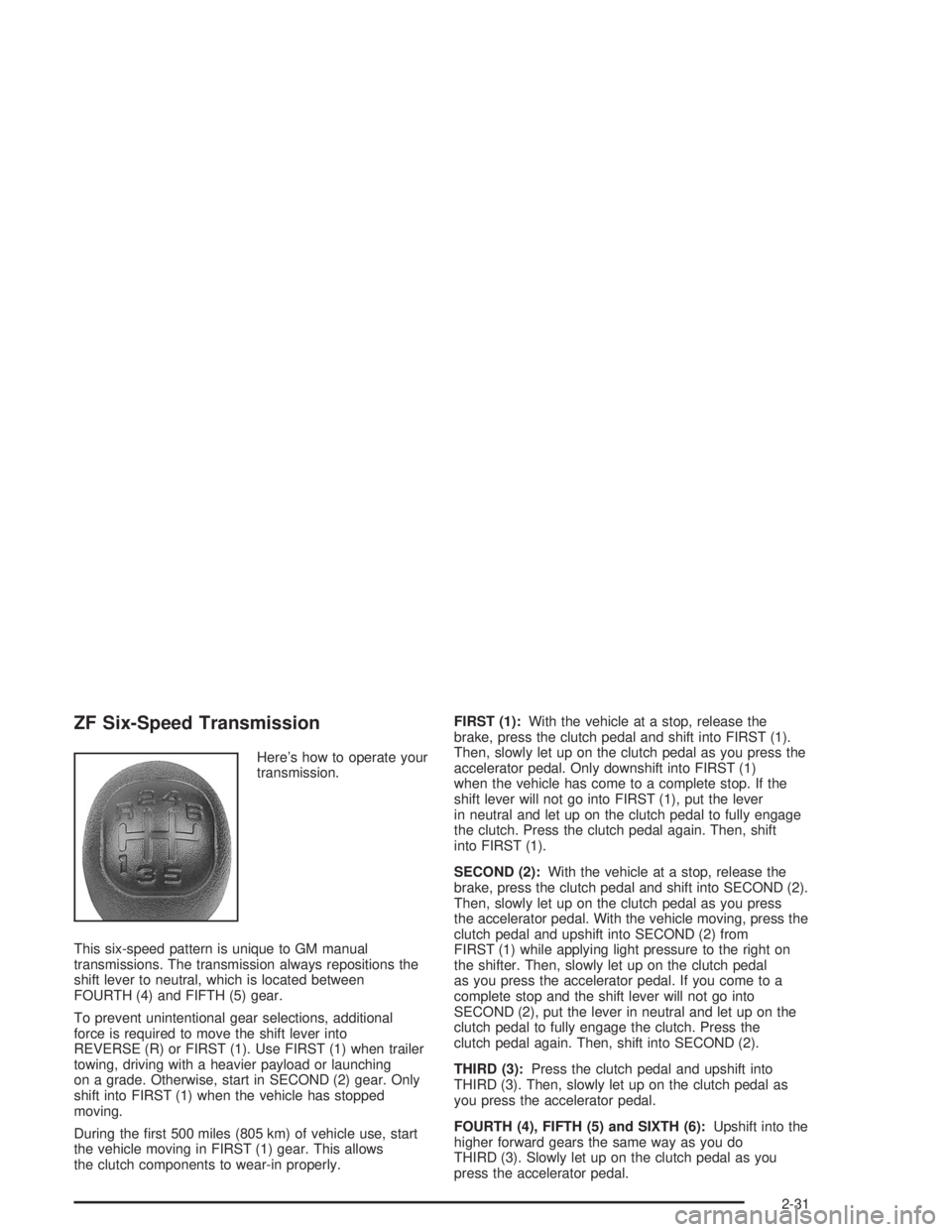
ZF Six-Speed Transmission
Here’s how to operate your
transmission.
This six-speed pattern is unique to GM manual
transmissions. The transmission always repositions the
shift lever to neutral, which is located between
FOURTH (4) and FIFTH (5) gear.
To prevent unintentional gear selections, additional
force is required to move the shift lever into
REVERSE (R) or FIRST (1). Use FIRST (1) when trailer
towing, driving with a heavier payload or launching
on a grade. Otherwise, start in SECOND (2) gear. Only
shift into FIRST (1) when the vehicle has stopped
moving.
During the first 500 miles (805 km) of vehicle use, start
the vehicle moving in FIRST (1) gear. This allows
the clutch components to wear-in properly.FIRST (1):With the vehicle at a stop, release the
brake, press the clutch pedal and shift into FIRST (1).
Then, slowly let up on the clutch pedal as you press the
accelerator pedal. Only downshift into FIRST (1)
when the vehicle has come to a complete stop. If the
shift lever will not go into FIRST (1), put the lever
in neutral and let up on the clutch pedal to fully engage
the clutch. Press the clutch pedal again. Then, shift
into FIRST (1).
SECOND (2):With the vehicle at a stop, release the
brake, press the clutch pedal and shift into SECOND (2).
Then, slowly let up on the clutch pedal as you press
the accelerator pedal. With the vehicle moving, press the
clutch pedal and upshift into SECOND (2) from
FIRST (1) while applying light pressure to the right on
the shifter. Then, slowly let up on the clutch pedal
as you press the accelerator pedal. If you come to a
complete stop and the shift lever will not go into
SECOND (2), put the lever in neutral and let up on the
clutch pedal to fully engage the clutch. Press the
clutch pedal again. Then, shift into SECOND (2).
THIRD (3):Press the clutch pedal and upshift into
THIRD (3). Then, slowly let up on the clutch pedal as
you press the accelerator pedal.
FOURTH (4), FIFTH (5) and SIXTH (6):Upshift into the
higher forward gears the same way as you do
THIRD (3). Slowly let up on the clutch pedal as you
press the accelerator pedal.
2-31
Page 100 of 366
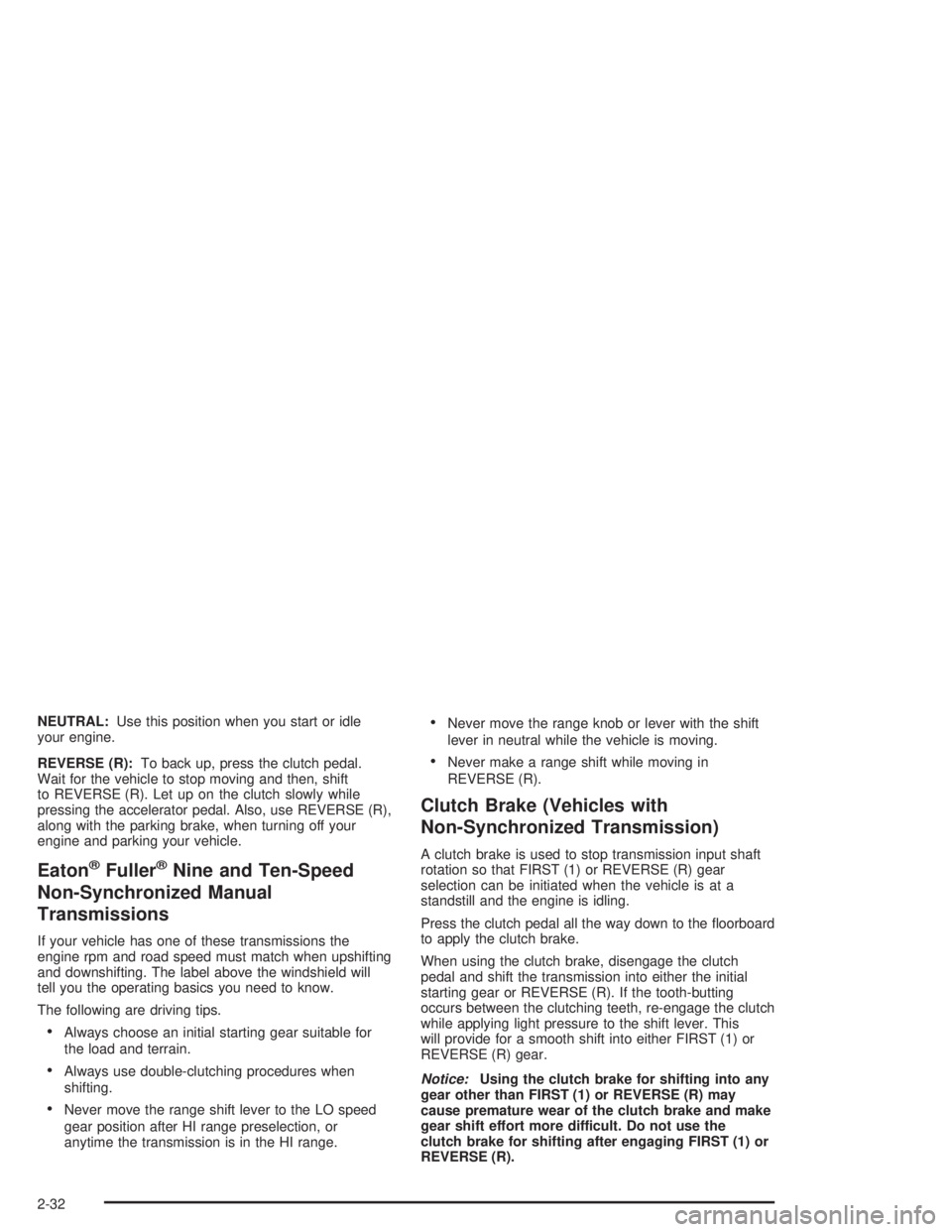
NEUTRAL:Use this position when you start or idle
your engine.
REVERSE (R):To back up, press the clutch pedal.
Wait for the vehicle to stop moving and then, shift
to REVERSE (R). Let up on the clutch slowly while
pressing the accelerator pedal. Also, use REVERSE (R),
along with the parking brake, when turning off your
engine and parking your vehicle.
Eaton®Fuller®Nine and Ten-Speed
Non-Synchronized Manual
Transmissions
If your vehicle has one of these transmissions the
engine rpm and road speed must match when upshifting
and downshifting. The label above the windshield will
tell you the operating basics you need to know.
The following are driving tips.
•Always choose an initial starting gear suitable for
the load and terrain.
•Always use double-clutching procedures when
shifting.
•Never move the range shift lever to the LO speed
gear position after HI range preselection, or
anytime the transmission is in the HI range.
•Never move the range knob or lever with the shift
lever in neutral while the vehicle is moving.
•Never make a range shift while moving in
REVERSE (R).
Clutch Brake (Vehicles with
Non-Synchronized Transmission)
A clutch brake is used to stop transmission input shaft
rotation so that FIRST (1) or REVERSE (R) gear
selection can be initiated when the vehicle is at a
standstill and the engine is idling.
Press the clutch pedal all the way down to the floorboard
to apply the clutch brake.
When using the clutch brake, disengage the clutch
pedal and shift the transmission into either the initial
starting gear or REVERSE (R). If the tooth-butting
occurs between the clutching teeth, re-engage the clutch
while applying light pressure to the shift lever. This
will provide for a smooth shift into either FIRST (1) or
REVERSE (R) gear.
Notice:Using the clutch brake for shifting into any
gear other than FIRST (1) or REVERSE (R) may
cause premature wear of the clutch brake and make
gear shift effort more difficult. Do not use the
clutch brake for shifting after engaging FIRST (1) or
REVERSE (R).
2-32